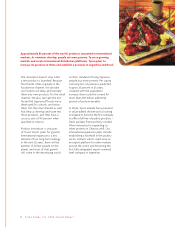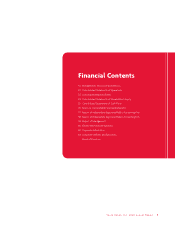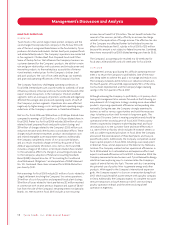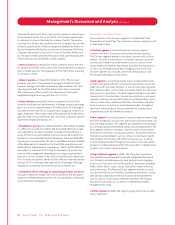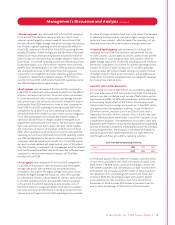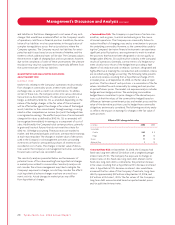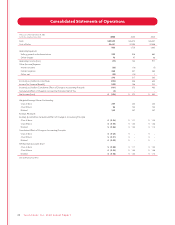Tyson Foods 2006 Annual Report Download - page 20
Download and view the complete annual report
Please find page 20 of the 2006 Tyson Foods annual report below. You can navigate through the pages in the report by either clicking on the pages listed below, or by using the keyword search tool below to find specific information within the annual report.
retirement obligation if the fair value of the liability can be reason-
ably estimated. Uncertainty about the timing and/or method of
settlement of a conditional asset retirement obligation should be
factored into the measurement of the liability when sufficient
information exists. The Company adopted FIN 47 as of September 30,
2006. See Note 2, “Change in Accounting Principle” in the Notes to
Consolidated Financial Statements for the impact of the adoption
of FIN 47.
In September 2005, the Emerging Issues Task Force (EITF) reached a
consensus on Issue No. 04-13, “Accounting for Purchases and Sales
of Inventory with the Same Counterparty.” The issues were the
circumstances under which two or more inventory purchase and
sales transactions with the same counterparty should be viewed
as a single exchange transaction within the scope of Accounting
Principles Board Opinion 29, “Accounting for Nonmonetary Trans-
actions” and circumstances under which nonmonetary exchanges
of inventory within the same line of business should be recognized
at fair value. The Company adopted EITF Issue No. 04-13 in the third
quarter of fiscal 2006. The adoption of this Issue did not have a
material impact on the Company’s consolidated financial statements.
RECENTLY ISSUED ACCOUNTING STANDARDS
AND REGULATIONS
In June 2006, the FASB issued Interpretation No. 48, “Accounting
for Uncertainty in Income Taxes,” an interpretation of FASB State-
ment No. 109 (FIN 48). FIN 48 prescribes a recognition threshold
and measurement attribute for the financial statement recognition
and measurement of a tax position taken or expected to be taken
in a tax return. FIN 48 also provides guidance on derecognition,
classification, interest and penalties, accounting in interim periods,
disclosureand transition. FIN 48 is effective for fiscal years begin-
ning after December 15, 2006; therefore, the Company expects
to adopt FIN 48 at the beginning of fiscal 2008. The Company is
currently in the process of evaluating the potential impact of FIN 48.
In September 2006, the FASB issued Statement of Financial Account-
ing Standards No. 157, “Fair Value Measurements” (SFAS No. 157).
SFAS No. 157 provides guidance for using fair value to measure assets
and liabilities. This standard also responds to investors’ requests for
expanded information about the extent to which companies mea-
sure assets and liabilities at fair value, the information used to measure
fair value and the effect of fair value measurements on earnings.
SFAS No. 157 applies whenever other standards require (or permit)
assets or liabilities to be measured at fair value. The standard does
not expand the use of fair value in any new circumstances. SFAS
No. 157 is effective for financial statements issued for fiscal years
beginning after November 15, 2007, and interim periods within
those fiscal years; therefore the Company expects to adopt SFAS
No. 157 at the beginning of fiscal 2009. The Company is currently in
the process of evaluating the potential impact of SFAS No. 157.
In September 2006, the FASB issued Statement of Financial
Accounting Standards No. 158, “Employers’ Accounting for Defined
Benefit Pension and Other Postretirement Plans, an amendment
of FASB Statements No. 87, 88, 106, and 132(R)” (SFAS No. 158).
SFAS No. 158 requires companies to recognize the overfunded or
underfunded status of a defined benefit postretirement plan as an
asset or liability in its consolidated balance sheet and to recognize
changes in that funded status in the year in which the changes occur
through other comprehensive income. This standard also requires
companies to measure the funded status of a plan as of the date
of its annual consolidated balance sheet, with limited exceptions.
SFAS No. 158 is effective for financial statements issued for fiscal
years ending after December 15, 2006; therefore, the Company
expects to adopt SFAS No. 158 at the end of fiscal 2007. Based on
the information available at September 30, 2006, the Company
expects an increase in assets of $6 million, an increase in liabilities
of $8 million and an adjustment to accumulated other comprehen-
sive income of $2 million when it adopts SFAS No. 158.
In September 2006, the Securities and Exchange Commission staff
published Staff Accounting Bulletin No. 108, “Considering the Effects
of Prior Year Misstatements when Quantifying Misstatements in
Current Year Financial Statements” (SAB 108). SAB 108 addresses
quantifying the financial statement effects of misstatements,
specifically, how the effects of prior year uncorrected errors must
be considered in quantifying misstatements in the current year
financial statements. SAB 108 is effective for fiscal years ending
after November 15, 2006; therefore, the Company expects to adopt
SAB 108 at the end of fiscal 2007. The Company is currently in the
process of evaluating the potential impact of SAB 108.
CRITICAL ACCOUNTING ESTIMATES
The preparation of consolidated financial statements requires man-
agement to make estimates and assumptions. These estimates and
assumptions affect the reported amounts of assets and liabilities
and disclosure of contingent assets and liabilities at the date of the
consolidated financial statements and the reported amounts of
revenues and expenses during the reporting period. Actual results
could differ from those estimates. The following is a summary of
certain accounting estimates considered critical by the Company.
• Financial instruments: The Company is a purchaser of certain
commodities, such as grains, livestock and natural gas in the course
of normal operations. The Company uses derivative financial instru-
ments to reduce its exposure to various market risks. Generally,
contract terms of a hedge instrument closely mirror those of the
hedged item, providing a high degree of risk reduction and correla-
tion. Contracts designated and highly effective at meeting the risk
reduction and correlation criteria are recorded using hedge account-
ing, as defined by Statement of Financial Accounting Standards
No. 133, “Accounting for Derivative Instruments and Hedging Activ-
ities” (SFAS No. 133), as amended. If a derivative instrument is a
hedge, as defined by SFAS No. 133, depending on the nature of
the hedge, changes in the fair value of the instrument will be offset
18 Ty s on Foods, Inc. 2006 Annual Report
Management’s Discussion and Analysiscontinued


